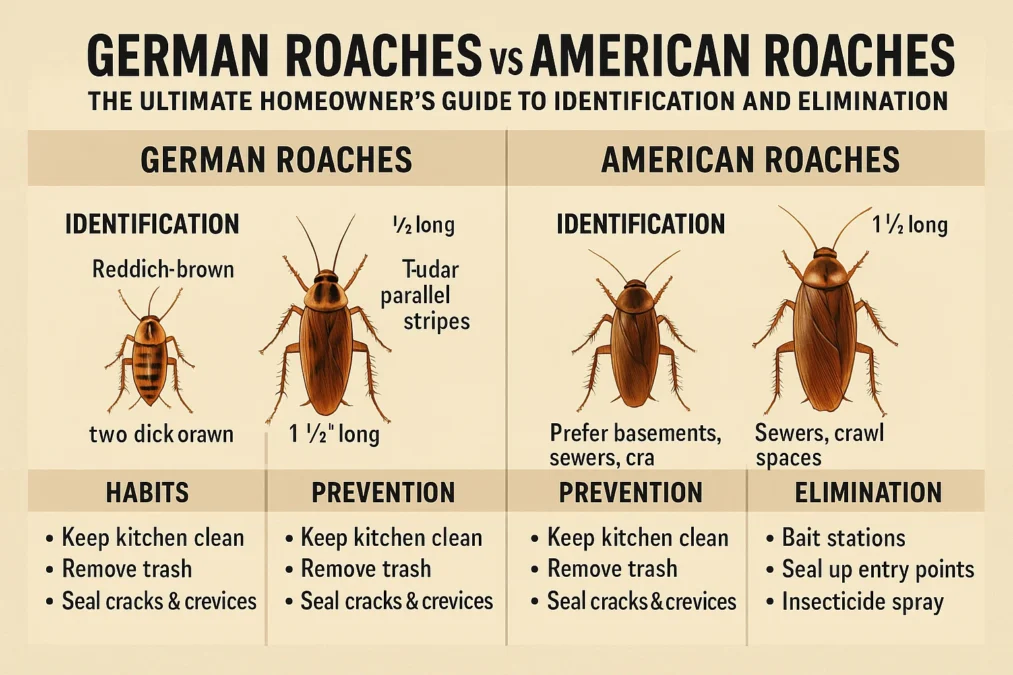You see a scurry, a flash of brown, and a sinking feeling in your gut. A cockroach. It’s a universal sign of unwelcome company. But before you grab the nearest shoe or can of spray, it’s crucial to understand exactly what you’re dealing with. Not all roaches are created equal, and misidentifying your six-legged intruder can lead to failed DIY efforts and a much larger problem down the line. The two most common (and most dreaded) household invaders are the German cockroach and the American cockroach. While their names might suggest a geographic preference, both are global pests found in homes and businesses worldwide. Understanding the critical differences between german roaches vs american roaches is the first and most important step in effectively eliminating them. This guide will be your comprehensive resource, diving deep into their biology, habits, and the most effective strategies to reclaim your space.
The battle against cockroaches is as much about knowledge as it is about insecticide. Think of it this way: you wouldn’t use the same strategy to fight a ground war as you would a naval battle. The German cockroach is a relentless indoor guerilla fighter, thriving in the hidden nooks of your kitchen. The American cockroach is more like an occasional raider, often coming in from the outside seeking shelter and resources. By the end of this article, you will be an expert in telling them apart, understanding their motivations, and deploying the right tactics to achieve a roach-free home. Let’s dive into the fascinating, if slightly unsettling, world of these two prolific pests.
Meet the Contenders: A Brief Overview
Before we get into the nitty-gritty details of size, shape, and habitat, it’s helpful to have a high-level understanding of these two species. Their common names are a bit misleading, as neither is exclusively native to their namesake region. The German cockroach (Blattella germanica) is actually believed to have originated in Southeast Asia, but it spread across the globe with humans, becoming the world’s most prevalent cockroach pest. It is the quintessential “house roach,” perfectly adapted to living in close association with people, rarely venturing outdoors in colder climates.
The American cockroach (Periplaneta americana), on the other hand, is a bit of a misnomer. It likely originated in Africa and was introduced to the Americas via shipping routes centuries ago. It is now common throughout the world, particularly in warmer climates. This species is often called the “palmetto bug,” especially in the southeastern United States. Unlike the German cockroach, the American variety often lives outdoors but will readily move indoors in search of food, water, or more favorable conditions, especially during dry or cold weather. This fundamental difference—indoor breeder vs. outdoor invader—shapes every aspect of how you will deal with an infestation.
Palmetto Bug vs Cockroach: Unravelling the Creepy-Crawly Confusion
Key Physical Differences: Spotting the Signs
The most immediate way to tell german roches vs american roaches apart is by their appearance. While both are cockroaches and share the general characteristics of flattened oval bodies, long antennae, and spiny legs, a side-by-side comparison reveals stark contrasts.
The German cockroach is small. Adults typically reach only about 1/2 to 5/8 of an inch in length. They are a light tan to golden brown color and are easily identified by the two dark, almost parallel stripes running down the length of their pronotal shield (the plate-like structure that covers their head). Their wings are fully developed but they are poor fliers, more likely to scuttle away at lightning speed than to take to the air. Nymphs (baby roaches) are smaller, darker, almost black, and lack wings, but they still possess the characteristic stripes.
In dramatic contrast, the American cockroach is a giant. Adults are one of the largest common cockroach species, measuring a whopping 1.5 to 2 inches in length, sometimes even larger. Their color is a reddish-brown, often with a yellowish margin on the pronotal shield. Unlike the distinct stripes of the German, the American roach’s pronotum has a more amorphous, darker-colored pattern. Their wings are long and functional; males are capable of short, clumsy flights, especially in warm weather. Nymphs are smaller versions of the adults but are wingless and often have a slightly different coloration until they mature.
Habitats and Behavior: Where They Live and How They Act
Understanding where these pests prefer to live is perhaps the most critical factor in identification and control. Their chosen habitats are a direct reflection of their biology and survival strategies, and getting this right is the key to effective extermination.
German cockroaches are almost exclusively indoor pests. They are thigmotropic, meaning they prefer tight, enclosed spaces where their bodies are touching surfaces above and around them. This is why they thrive in the cracks and crevices of a human habitat. You will find them hiding in the seams of appliances (especially refrigerators, dishwashers, and stoves), inside cabinets, behind electrical outlets, in the folds of cardboard boxes, and in any small, dark, warm, and humid space near a food and water source. They are prolific and spend the vast majority of their lives hidden, only venturing out to forage. Seeing one during the day is a major red flag, as it often indicates a severe, overcrowded infestation.
American cockroaches, conversely, are primarily outdoor pests. They are commonly found in sewers, storm drains, mulch, flowerbeds, under leaf litter, in woodpiles, and in the hollows of trees. They are attracted to decaying organic matter. They enter homes and buildings seeking food or, more commonly, to escape unfavorable outdoor conditions like extreme heat, drought, or cold. Once inside, they tend to congregate in areas that mimic their damp outdoor environments. Common indoor harborage sites include basements, crawl spaces, laundry rooms, bathrooms, and around plumbing pipes and drains. They are less secretive than German cockroaches and are often seen scurrying across a basement floor or even a living room at night.
The Life Cycle and Reproduction: A Numbers Game
When it comes to infestation potential, the reproductive rate of these two pests is where the true horror lies. Both are incredibly prolific, but one is on an entirely different level, making rapid intervention absolutely essential.
The German cockroach is the undisputed champion of reproduction. A single female can produce an egg case (called an ootheca) containing 30 to 48 eggs every few weeks. She carries this ootheca protruding from her abdomen until just a day or two before the eggs hatch, protecting them from harm. This high level of parental investment results in a very high hatch rate. From egg to adult can take as little as 36 days under ideal conditions (warm, with ample food and water). This means a single female can, theoretically, be responsible for thousands of offspring in a single year. This explosive reproductive potential is why a small German cockroach problem can become a full-blown, overwhelming infestation in a matter of months.
The American cockroach has a much slower reproductive cycle, though it is still highly effective. A female produces an ootheca containing about 16 eggs. Unlike the German roach, she does not carry it for long; she typically deposits it, or sometimes glues it, in a hidden, protected location within a day of its formation. The nymphs take significantly longer to mature, often between 6 months to over a year, depending on environmental conditions. While a single female will produce far fewer total offspring in her lifetime compared to a German female, the larger size of the American roach and the resilience of the nymphs still make them a formidable pest. Their slower reproduction means an infestation typically builds more slowly, but they can be just as difficult to eradicate due to their large size and ability to come in from outdoors.
Health Risks and Damage: More Than Just Ick Factor
No one wants cockroaches in their home because they’re creepy, but the real reason to eliminate them goes far beyond the “ick” factor. Both species pose significant risks to human health and property, though the nature of the risk varies slightly due to their different habitats.
German cockroaches are a premier vector for disease.因为他们 spend their entire lives in our kitchens and pantries, traversing from garbage and drains directly onto countertops, dishes, and food. They are known to carry and spread bacteria like Salmonella and E. coli, which can cause food poisoning and gastroenteritis. Their shed skins and feces are potent allergens, a major trigger for asthma attacks, especially in children. A significant infestation can create a distinct, unpleasant, and musty odor that permeates cupboards and the entire home. They can also cause minor damage by chewing on paper goods and packaging.
American cockroaches present similar, but often amplified, health concerns due to their preferred habitat. Living in sewers, drains, and decaying matter means they pick up a wide array of pathogens on their legs and bodies. When they trek into a home, they can contaminate surfaces with these germs. Their allergens are also potent and can trigger asthma and allergic reactions. Furthermore, their large size and habit of crawling on people’s faces at night (attracted by the moisture and salt) can be a source of significant psychological distress. While they are less likely to be found swarming in your food cabinets, the potential for disease transmission from their point of origin (sewers) to your home is a serious concern.
Effective Prevention Strategies: Keeping Them Out
An ounce of prevention is worth a pound of cure, and this old adage has never been truer than when dealing with cockroaches. The prevention strategies for these two pests overlap but also have unique elements based on their behavior.
For German cockroaches, prevention is all about impeccable indoor sanitation and exclusion. Since they are often brought in accidentally, be vigilant. Inspect grocery bags, cardboard boxes, second-hand furniture, and appliances before bringing them inside. Once inside, deny them what they need to survive. Store food in airtight containers, never leave dirty dishes in the sink overnight, and take out the trash regularly. Fix leaky faucets and pipes to eliminate water sources. Most importantly, seal up their hiding spots. Use caulk to fill cracks and crevices in cabinets, walls, and around pipes. Eliminate clutter, especially cardboard, which they love.
Preventing American cockroaches focuses more on fortifying the exterior of your home. Since they are outdoor invaders, your goal is to build a defensive barrier. Seal any cracks in the foundation, around windows and doors, and where utility lines and pipes enter the house. Ensure door sweeps are tight and weather stripping is intact. Install fine mesh screens over drain vents and sewer clean-outs. Outside, keep your yard clean. Remove leaf litter, store firewood well away from the house, and keep mulch layers thin. Ensure downspouts direct water away from the foundation to avoid creating damp soil that attracts them. Tightly sealing garbage cans and composting bins is also crucial to not provide an attractive food source near your home.
Treatment and Elimination: How to Win the War
When prevention fails and an infestation takes hold, the treatment plans for german roaches vs american roaches diverge significantly. Using the wrong approach is a waste of time and money and will only allow the population to grow.
Eradicating a German cockroach infestation is notoriously difficult and usually requires a multi-pronged approach. DIY sprays often fail because they only kill the roaches you see, driving the hidden population deeper into walls. The most effective modern strategy involves using baits and Insect Growth Regulators (IGRs). Cockroach gel baits are ideal because they are attractive food sources laced with a slow-acting poison. The roaches eat the bait, return to their harborage, and die. Other roaches then feed on their poisoned feces and carcasses, creating a powerful domino effect that reaches the heart of the colony. IGRs mimic insect hormones, preventing nymphs from maturing into reproducing adults and breaking the life cycle. Dusts like diatomaceous earth or boric acid can be carefully applied to voids and crevices to desiccate and kill roaches that walk through it. For severe infestations, professional pest control is highly recommended, as they have access to more potent products and the expertise to find and treat all harborage sites.
Eliminating American cockroaches often involves a more perimeter-based defense. While baits can still be effective (especially large roach baits placed in basements and crawl spaces), the focus is on creating a chemical barrier. Outdoor barrier treatments with residual insecticides applied around the foundation, doors, windows, and entry points can kill roaches before they get inside. Insecticide dusts are highly effective when puffed into wall voids, crawl spaces, and around plumbing penetrations. Because these roaches often come from sewer systems, ensuring drain traps are filled with water or installing drain covers can block this access route. While a sighting of a single American roach might not indicate a full-blown indoor infestation, consistent sightings warrant a targeted exterior and interior treatment to stop them at the source.
Comparison Table: German Roaches vs American Roaches at a Glance
| Feature | German Cockroach | American Cockroach |
|---|---|---|
| Scientific Name | Blattella germanica | Periplaneta americana |
| Size | 1/2″ – 5/8″ long | 1.5″ – 2″ long |
| Color | Light tan to golden brown | Reddish-brown |
| Key Marking | Two dark parallel stripes on pronotum | Yellowish margin on pronotum |
| Wings | Present, rarely flies | Present, capable of short flight |
| Preferred Habitat | Indoors (kitchens, bathrooms, appliances) | Outdoors (sewers, mulch, woodpiles); invades indoors |
| Reproduction Rate | Extremely High (30-48 eggs/case, carried by female) | Moderate (16 eggs/case, deposited) |
| Time to Maturity | ~36 days | 6 months – 1+ year |
| Primary Health Risk | Indoor allergen, food contamination | Vector of pathogens from sewers, allergen |
| Infestation Sign | Daytime sightings, droppings, egg cases | Occasional large roach sighted indoors |
| Control Focus | Indoor baiting, IGRs, sanitation, sealing cracks | Perimeter barrier treatments, sealing entry points |
“The German cockroach is the ultimate survivor, adapted to live with humans. The American cockroach is more of an opportunist, living near humans. This fundamental difference dictates every aspect of how we control them.” – A Professional Entomologist
“Seeing one German cockroach in the daytime is like seeing the tip of an iceberg. For every one you see, there are hundreds hidden away. With American roaches, a daytime sighting is less indicative of an indoor breeding population but a sign that they are finding easy access to your home.” – Pest Control Operator
Beyond the Big Two: Other Common Roaches to Know
While German and American roaches are the most common household pests, it’s helpful to be aware of other species you might encounter. The Oriental cockroach (Blatta orientalis), often called the “water bug,” is shiny black, about an inch long, and prefers extremely damp, cool areas like basements and crawl spaces. They are strong, slow-moving runners and give off a powerful odor. The Brown-banded cockroach (Supella longipalpa) is similar in size to the German roach but lacks the two stripes. Instead, it has two lighter bands across its wings and abdomen. Crucially, it prefers warmer, drier areas away from water sources, often found in bedrooms, closets, and behind picture frames, making its control strategy different from the German roach. The Smokybrown cockroach (Periplaneta fuliginosa) is a large, dark mahogany-colored roach common in the southeastern U.S. It is strongly attracted to light and is primarily an outdoor pest much like the American cockroach, requiring similar perimeter control methods.
Silkie Rooster vs Hen: Your Ultimate Guide to Telling Them Apart
Conclusion
The world of household pests is vast, but few invaders provoke the same immediate revulsion and urgency as the cockroach. However, as we’ve explored, not all roaches are the same. The key to victory in the battle for your home lies in accurate identification. Understanding the critical differences between german roaches vs american roaches—their size, markings, behavior, and preferred habitats—provides you with the intelligence needed to choose the right weapons and tactics. Remember, the German cockroach is a persistent indoor breeder demanding a focused interior assault with baits and IGRs, while the American cockroach is an outdoor invader requiring a strong perimeter defense and exclusion. Whether you choose the DIY route or call in a professional, your newfound knowledge will empower you to take effective action, protect your health, and finally achieve a pest-free home.
Frequently Asked Questions (FAQ)
What is the main difference between a German and an American cockroach?
The main difference lies in their size, habitat, and reproductive strategy. German cockroaches are small (about 1/2 inch), light brown with two dark stripes, and live almost exclusively indoors, breeding at an alarming rate. American cockroaches are very large (up to 2 inches), reddish-brown, and primarily live outdoors but will invade homes for shelter and resources, reproducing at a much slower pace.
Which cockroach is harder to get rid of, German or American?
Generally, German cockroaches are considered far harder to eradicate completely. This is because they live and breed entirely indoors, often in hidden, hard-to-reach areas within your kitchen and walls. Their incredibly rapid reproduction rate means a small problem can become a major infestation quickly. American roaches are often easier to manage because the breeding population is usually outside, so control focuses on creating a barrier to keep them out.
I saw a large cockroach in my basement. Is it an American cockroach?
It is very likely an American cockroach, as they are commonly found in damp, cool areas like basements, crawl spaces, and around floor drains. However, a large Oriental cockroach (which is shiny black) could also be a possibility. The reddish-brown color and size point strongly toward the American cockroach.
Can German cockroaches infest a clean house?
Yes, they absolutely can. While poor sanitation will attract them and help a population explode, German cockroaches are primarily brought into homes accidentally. They can hitch a ride in grocery bags, cardboard boxes, used appliances, or even on a purse or backpack. Once inside, even a clean home provides enough crumbs, water droplets, and hiding places to support an infestation, though impeccable cleanliness is a critical part of controlling and preventing them.
Do American cockroaches fly?
Yes, American cockroaches have fully developed wings and are capable of flight, though they are not elegant fliers. They typically use their wings to glide from high places to lower ones, such as from a tree onto a house. The sight of a large, flying cockroach can be particularly alarming, but it is a common behavior for this species, especially in warm weather.



